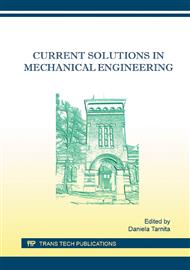[1]
T. B. Hughes, «Bioabsorbable Implants in the Treatment of Hand Fractures: An Update, Clinical Orthopaedics and Related Research», vol. 445, p.169 – 174, Feb. (2006).
DOI: 10.1097/01.blo.0000205884.81328.cc
Google Scholar
[2]
E. Waris, N. Ashammakhi, O. Kaarela, T. Raatikainen, and J. Vasenius, «Use of bioabsorbable osteofixation devices in the hand», J Hand Surg Br, vol. 29, no. 6, p.590–598, Dec. (2004).
DOI: 10.1016/j.jhsb.2004.02.005
Google Scholar
[3]
F. H. Vom Saal, «Intramedullary fixation in fractures of the hand and fingers», J Bone Joint Surg Am, vol. 35-A, no. 1, p.5–16; passim, Jan. 1953. |.
DOI: 10.2106/00004623-195335010-00002
Google Scholar
[4]
S. M. Page and P. J. Stern, «Complications and range of motion following plate fixation of metacarpal and phalangeal fractures», J Hand Surg Am, vol. 23, no. 5, p.827–832, Sep. (1998).
DOI: 10.1016/s0363-5023(98)80157-3
Google Scholar
[5]
P. J. Stern, M. J. Wieser, and D. G. Reilly, «Complications of plate fixation in the hand skeleton», Clin. Orthop. Relat. Res., no. 214, p.59–65, Jan. (1987).
DOI: 10.1097/00003086-198701000-00010
Google Scholar
[6]
N. Ashammakhi, A. M. Gonzalez, P. Törmälä, and I. T. Jackson, «New resorbable bone fixation. Biomaterials in craniomaxillofacial surgery: present and future», Eur J Plast Surg, vol. 26, no. 8, p.383–390, Nov. (2003).
DOI: 10.1007/s00238-003-0568-8
Google Scholar
[7]
N. Ashammakhi, H. Peltoniemi, E. Waris, R. Suuronen, W. Serlo, M. Kellomäki, P. Törmälä, and T. Waris, «Developments in craniomaxillofacial surgery: use of self-reinforced bioabsorbable osteofixation devices», Plast. Reconstr. Surg., vol. 108, no. 1, p.167–180, Jul. (2001).
DOI: 10.1097/00006534-200107000-00027
Google Scholar
[8]
E. Waris, N. Ashammakhi, T. Raatikainen, P. Törmälä, S. Santavirta, and Y. T. Konttinen, «Self-reinforced bioabsorbable versus metallic fixation systems for metacarpal and phalangeal fractures: a biomechanical study», J Hand Surg Am, vol. 27, no. 5, p.902–909, Sep. (2002).
DOI: 10.1053/jhsu.2002.35082
Google Scholar
[9]
E. Waris, N. Ashammakhi, H. Happonen, T. Raatikainen, O. Kaarela, P. Törmälä, S. Santavirta, and Y. T. Konttinen, «Bioabsorbable miniplating versus metallic fixation for metacarpal fractures», Clin. Orthop. Relat. Res., no. 410, p.310–319, May (2003).
DOI: 10.1097/01.blo.0000063789.32430.c6
Google Scholar
[10]
P. U. Rokkanen, O. Böstman, E. Hirvensalo, E. A. Mäkelä, E. K. Partio, H. Pätiälä, S. I. Vainionpää, K. Vihtonen, and P. Törmälä, «Bioabsorbable fixation in orthopaedic surgery and traumatology», Biomaterials, vol. 21, no. 24, p.2607–2613, Dec. (2000).
DOI: 10.1016/s0142-9612(00)00128-9
Google Scholar
[11]
C. Dumont, M. Fuchs, H. Burchhardt, D. Appelt, S. Bohr, and K. M. Stürmer, «Clinical results of absorbable plates for displaced metacarpal fractures», J Hand Surg Am, vol. 32, no. 4, p.491–496, Apr. (2007).
DOI: 10.1016/j.jhsa.2007.02.005
Google Scholar


